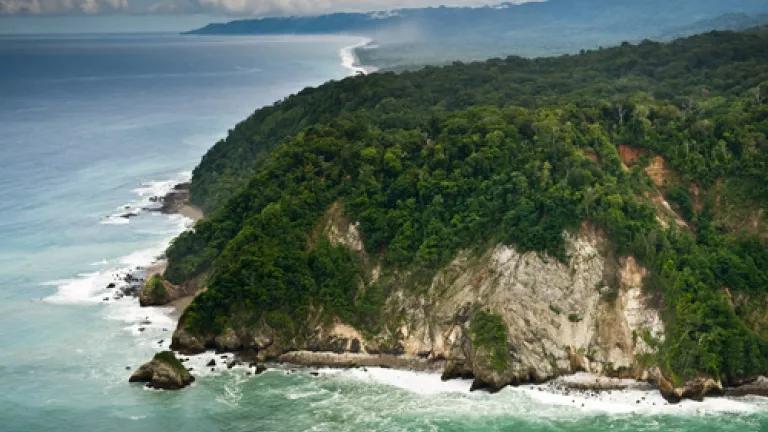
Last week Costa Rica’s President Laura Chinchilla was awarded the Peter Benchley Ocean Award for Excellence in National Stewardship of the Ocean for her role in expanding protections for Cocos Island National Park in the Pacific Ocean. Hopefully Costa Rica’s Osa Peninsula and Térraba-Sierpe Wetlands are next in line for this type of attention and additional conservation support.
Photo Credit: CAVU
Teeming with hammerhead sharks, dolphins, rays and other marine life, the waters surrounding Cocos Island - a remote, uninhabited rainforest island nearly halfway between mainland Costa Rica and the Galapagos - are among the richest marine habitat in the world. The award to President Chinchilla rightly recognizes Costa Rica’s environmental leadership in marine biodiversity protection. It also highlights how much more can still be done to ensure sustainability of Costa Rica’s marine and coastal resources. This is one of the reasons that NRDC designated Costa Rica as a BioGem and in recent work is focusing on conservation of the Osa Peninsula and the nearby Térraba-Sierpe Wetlands on Costa Rica’s southern Pacific coast.
Protected areas are critical for preserving marine and coastal biodiversity – as well as ensuring environmental and economic stability for local communities. In Mexico’s Baja Peninsula, also an NRDC BioGem, the creation of the Cabo Pulmo National Marine Park helped revive a key coral reef that had been degraded by overfishing and unsustainable fishing techniques. The reef is now a thriving marine habitat and an example of a true conservation success that must continue to be protected. Yet in order for conservation efforts to truly succeed it’s critical to ensure actions outside of park borders are also environmentally sustainable. Costa Rica’s Cocos Island National Park was for years a marine oasis with one of the highest densities of sharks on the planet. Right outside the park’s perimeter, however, unsustainable fishing techniques by tuna liners critically damaged marine habitat and resources, placing tremendous pressure on the park’s biodiversity. We see this same problem throughout the region – including in Costa Rica’s Osa Peninsula and Térraba-Sierpe Wetlands. Without a process that includes environmentally sustainable community development and community involvement in conservation, protected areas can become isolated and under threat.
The growing threat to Cocos Island’s marine wildlife was widely recognized and finally - thanks to years of collaborative effort by the Costa Rican Government and local and international civil society - President Chinchilla signed an Executive Decree creating the new Seamount Marine Management Area. This new management area expands protections around Cocos Island by over 3,700 square miles in which only low-impact fishing practices are allowed (for a map of the expanded protections, click here.) With these new protections Costa Rica took an important step toward ensuring the continued preservation of a place that is “too precious to ignore”, as Nancy Sutley, Chair of the White House Council on Environmental Quality, noted during last week’s award ceremony.
In her award acceptance speech President Chinchilla recognized that Costa Rica has more work to do in terms of protecting its marine and coastal resources. This is indeed true. Another region where Costa Rica should now focus is its southern pacific coast where the Osa Peninsula and Térraba-Sierpe Wetlands are two other places that are simply too precious to ignore. Less than half the size of Rhode Island, the Osa Peninsula is home to approximately half of Costa Rica’s 500,0000 species. Slightly to the north of the peninsula, the Térraba – Sierpe Wetlands are home to the largest intact mangrove forests in Central America and shelter countless species of birds and other wildlife. In addition, the ecosystem services these wetlands provide are valued at between $300,000,000 to nearly $2,000,000,000. Yet these fragile coastal wetlands face growing pressure from upstream activities such as unsustainable real-estate development, expanding industrial agricultural and a proposed new international airport that could lead to massive over development in the absence of appropriate planning for the region.
During the awards ceremony President Chinchilla was acknowledged for her great courage and vision in seeing that the creation of the new protected zone around Cocos Island would benefit Costa Rica’s people, economy and ecological treasures. President Chinchilla should now make it a priority for her government to work collaboratively with civil society and local stakeholders to ensure that any activities in the Osa Peninsula and near the Térraba-Sierpe Wetlands are sustainable and in line with Costa Rica’s biodiversity conservation goals.

